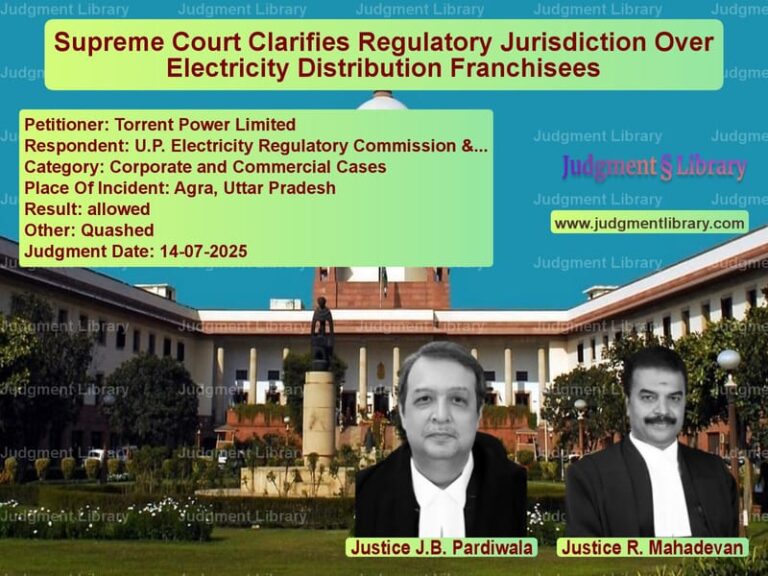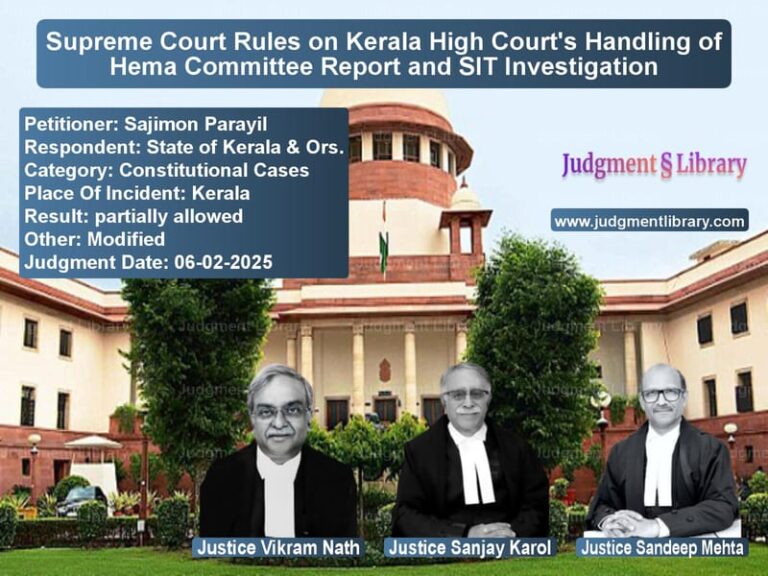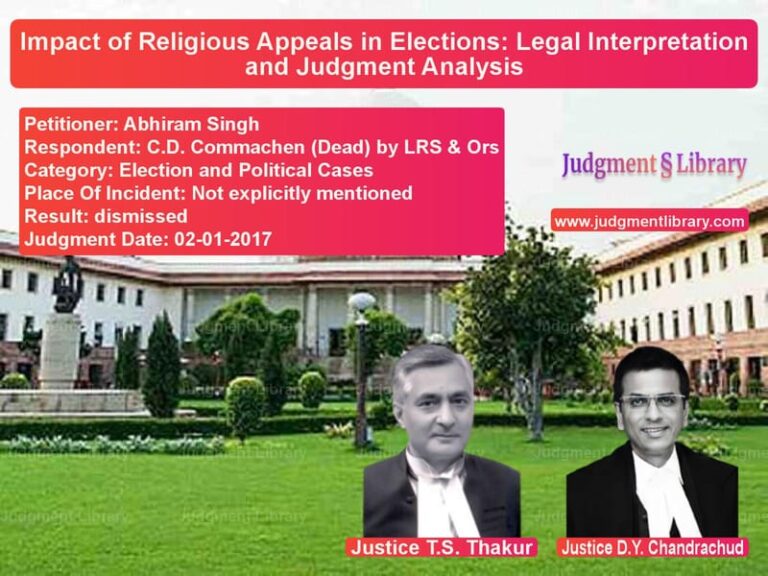Supreme Court Acquits Convicts in Karnataka Murder Case Citing Lack of Evidence
The case of Manjunath & Ors. v. State of Karnataka involved the Supreme Court overturning a High Court conviction in a murder case due to insufficient and unreliable evidence. The judgment is crucial in defining the legal principles surrounding dying declarations, eyewitness testimony, and circumstantial evidence in criminal cases.
Background of the Case
The case stemmed from an incident on August 6, 1997, in Karnataka, where the deceased, Byregowda, and his brothers were allegedly attacked by a group of assailants while working in their fields. Several accused were said to have attacked the deceased with iron rods and a chopper, leading to his grievous injuries and eventual death.
A total of 29 accused were charged under multiple sections of the Indian Penal Code, including Sections 143, 144, 146, 147, 148, 447, 324, 326, 504, and 506 read with Section 149. The case proceeded through the Sessions Court, the Karnataka High Court, and eventually, the Supreme Court.
Trial Court Findings
The Trial Court examined the prosecution’s case under five key aspects:
- Ocular Evidence: The court noted that crucial eyewitnesses (PW2 and PW15) did not support the prosecution. There were inconsistencies in their testimonies regarding the sequence of events, raising doubts about the reliability of their accounts.
- Dying Declaration: The dying declaration of the deceased was deemed unreliable as the police officer who recorded it admitted that it was written by someone else (not examined as a witness). There was also no certification from the doctor that the deceased was in a fit state to give a statement.
- Circumstantial Evidence: Witness testimonies failed to establish a clear link between the accused and the crime, leading the court to conclude that the circumstantial evidence did not unerringly point to the guilt of the accused.
- Recovery of Incriminating Material: The court found the recovery of weapons questionable, as they were found in public areas accessible to many people, making it difficult to conclusively link them to the accused.
- Motive: While there was evidence of past enmity between the accused and the deceased, the court ruled that this alone was insufficient to establish guilt beyond reasonable doubt.
The Sessions Court acquitted all 29 accused due to insufficient evidence.
High Court Decision
The Karnataka High Court overturned the acquittal for six of the accused—Manjunath (A1), Ramegowda (A2), Ramappa (A3), Ramesh (A4), Manjunatha (A5), and Dyavappa (A7). It held that the dying declaration was credible and matched the medical evidence. These six were convicted under Section 304 Part II IPC and sentenced to four years of rigorous imprisonment and a fine of ₹5000 each.
The High Court ruled:
- The dying declaration was consistent with the injuries found on the deceased.
- Eyewitnesses corroborated the attack.
- The accused had past enmity with the deceased, which provided motive.
Supreme Court’s Verdict
The Supreme Court set aside the High Court’s conviction and restored the acquittal, emphasizing that the prosecution failed to establish guilt beyond a reasonable doubt.
The key reasons for acquittal were:
1. Doubts Regarding the Dying Declaration
The Supreme Court noted serious deficiencies in the dying declaration:
- The declaration was written by a police officer’s subordinate who was never examined in court.
- The doctor did not certify that the deceased was in a fit mental state to give a statement.
- The statement was recorded in the presence of multiple people, raising concerns about tutoring or influence.
- The deceased, though literate, provided a thumb impression instead of a signature, which was unexplained.
“The dying declaration, although undoubtedly a substantive piece of evidence, is rendered nugatory as the person who took down such declaration was not examined.”
2. Unreliable Eyewitness Testimony
The Court found significant contradictions in the testimonies of the prosecution’s eyewitnesses:
- There was inconsistency in the number of accused involved (some witnesses said 50-60 people, while others said 25-30).
- The location where the deceased was found was unclear.
- Some witnesses, including a close relative (PW4), fled the scene instead of helping the deceased, raising doubts about their credibility.
The Supreme Court emphasized:
“For an eyewitness to be believed, his evidence should be of sterling quality. Numerous contradictions and inconsistencies have borne from the record, rendering such witnesses unreliable.”
3. Weak Circumstantial Evidence
The circumstantial evidence failed to conclusively establish the guilt of the accused. The Court ruled that mere presence at the scene or past enmity does not prove participation in the crime.
4. Flawed Recovery of Weapons
The Supreme Court ruled that the recovery of weapons did not meet the legal requirements under Section 27 of the Indian Evidence Act:
- Weapons were found in public places, accessible to many people.
- There was no forensic link between the weapons and the injuries sustained by the deceased.
- The alleged weapons (clubs and iron rods) did not match the nature of the wounds.
“The Trial Court was correct in disregarding the weapon recovery, as the seized objects were found in places accessible to the public.”
5. Error in the High Court’s Judgment
The Supreme Court held that the High Court erred in overturning the Trial Court’s acquittal:
- The High Court failed to apply the principle that an acquittal should only be reversed if there are “very compelling reasons.”
- Presumption of innocence is stronger after an acquittal.
- The High Court did not provide strong reasoning for reversing the Trial Court’s findings.
Final Ruling
The Supreme Court restored the acquittals granted by the Trial Court:
“The judgment of conviction and sentence, as awarded by the High Court, stands set aside.”
The Court ordered the refund of fines paid by the accused and the discharge of their bail bonds.
Implications of the Judgment
1. Importance of Procedural Fairness
The ruling highlights the need for proper documentation and verification of dying declarations.
2. Strengthening Standards for Eyewitness Testimony
Eyewitnesses must provide consistent, reliable accounts to be considered credible.
3. Judicial Caution in Overturning Acquittals
Acquittals should only be overturned with strong reasoning and compelling evidence.
Conclusion
The Supreme Court’s judgment in this case reinforces fundamental principles of criminal law—ensuring that convictions are based on credible, corroborated, and legally sound evidence. The decision safeguards the rights of accused individuals while emphasizing strict evidentiary standards in criminal trials.
Petitioner Name: Manjunath & Ors..Respondent Name: State of Karnataka.Judgment By: Justice Abhay S. Oka, Justice Sanjay Karol.Place Of Incident: Karnataka.Judgment Date: 05-11-2023.
Don’t miss out on the full details! Download the complete judgment in PDF format below and gain valuable insights instantly!
Download Judgment: manjunath-&-ors.-vs-state-of-karnataka-supreme-court-of-india-judgment-dated-05-11-2023.pdf
Directly Download Judgment: Directly download this Judgment
See all petitions in Murder Cases
See all petitions in Bail and Anticipatory Bail
See all petitions in Juvenile Justice
See all petitions in Judgment by Abhay S. Oka
See all petitions in Judgment by Sanjay Karol
See all petitions in allowed
See all petitions in Quashed
See all petitions in supreme court of India judgments November 2023
See all petitions in 2023 judgments
See all posts in Criminal Cases Category
See all allowed petitions in Criminal Cases Category
See all Dismissed petitions in Criminal Cases Category
See all partially allowed petitions in Criminal Cases Category







